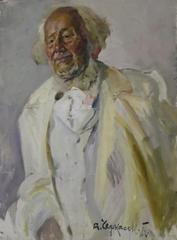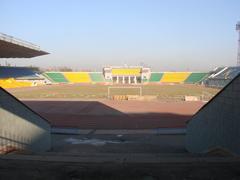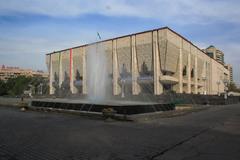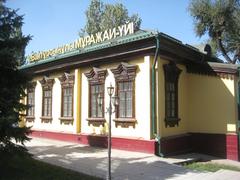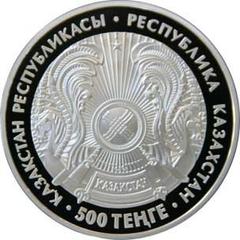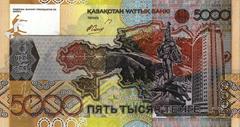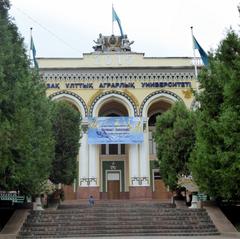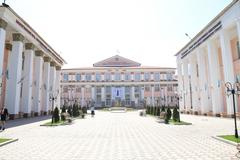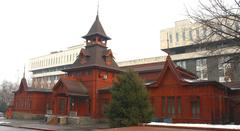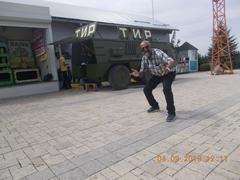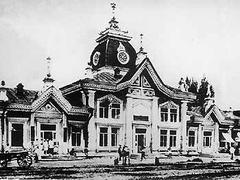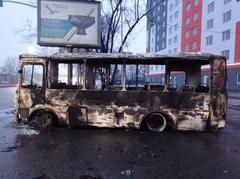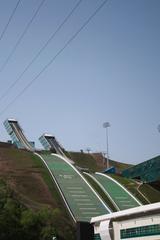Kensai Cemetery Almaty, Kazakhstan: Visitor Hours, Tickets, and Comprehensive Guide
Date: 15/06/2025
Introduction
Kensai Cemetery, nestled on the eastern hills of Almaty, Kazakhstan, is a site of profound historical, cultural, and spiritual significance. As one of the city’s oldest and most revered burial grounds, Kensai reflects Almaty’s multicultural legacy, religious diversity, and turbulent history from the Russian imperial era through Soviet times to modern Kazakhstan. This guide provides an in-depth overview of Kensai Cemetery—including its origins, notable burials, cultural importance, visitor information, accessibility, transportation, and nearby attractions—empowering travelers and heritage enthusiasts to explore this landmark respectfully and meaningfully.
Historical and Cultural Significance
Origins and Evolution
Kensai Cemetery’s foundation is intertwined with Almaty’s transformation from a Silk Road settlement to a cosmopolitan urban center. Established during the Russian Empire’s expansion in the 19th century, the cemetery became a principal resting place for the growing and diverse population of Verny (now Almaty) (welcome.kz). Kensai’s graves tell stories of migration, upheaval, and community evolution, with burials spanning multiple religious and ethnic backgrounds.
Multicultural Identity
Throughout the Soviet era and into Kazakhstan’s independence, Kensai Cemetery mirrored the city’s shifting demographics. It is home to ethnic Kazakhs, Russians, Uighurs, Tatars, and others, with gravestones inscribed in multiple languages and reflecting Islamic, Orthodox Christian, and secular Soviet traditions (astanatimes.com). This diversity makes Kensai not only a burial ground but also a living archive of Almaty’s multifaceted identity.
Notable Burials and Memorials
While Kensai lacks some of the monumental grandeur of other world cemeteries, it is the final resting place for many of Almaty’s prominent figures—intellectuals, artists, scientists, war veterans, and community leaders. The cemetery also features memorials to victims of 20th-century political repression, serving as a site of remembrance for families and the broader community (vlast.kz).
Religious and Cultural Practices
Kensai’s layout and grave markers reflect religious customs: Muslim graves face Mecca and feature kulpytas (traditional gravestones), while Orthodox Christian graves display crosses and are oriented eastward (adventurebackpack.com). Community members observe rituals such as offering prayers, placing flowers, and sharing meals at gravesites during significant dates, blending Islamic and pre-Islamic traditions.
Preservation and Urban Development
Like many historic cemeteries, Kensai faces challenges from urban expansion and shifting attitudes toward heritage preservation. While some cemeteries in Kazakhstan have been relocated or partially demolished for infrastructure projects, Kensai has remained largely intact, owing to its protected status and advocacy from local communities (vlast.kz). Ongoing efforts focus on preserving its historic sections and raising awareness about its cultural value.
Practical Visitor Information
Location and Layout
Kensai Cemetery is approximately 9 km east of Almaty’s city center, situated at the intersection of Bazarbayev and Ormanov streets. It is divided into Kensai-1 (the older, historic section) and Kensai-2 (the active burial ground), with winding unpaved paths, mature trees, and panoramic city views (World Cemeteries).
Visiting Hours
- General Hours: Kensai Cemetery is open daily from 8:00 AM to 6:00 PM.
- Best Time to Visit: Spring and autumn provide pleasant weather; early mornings or late afternoons offer optimal lighting and tranquility.
- Special Considerations: Visiting hours may vary or be restricted during public holidays or religious observances.
Tickets and Entry
- Admission: Free of charge; no tickets required.
- Donations: Voluntary contributions for maintenance are welcome.
Dress Code and Etiquette
- Attire: Modest clothing is essential; men should wear long trousers and sleeved shirts, women should cover arms and legs and wear a headscarf near graves.
- Behavior: Maintain silence, avoid loud conversations, and do not photograph mourners or individual graves without permission.
- Photography: Permitted for landscapes and monuments; respect privacy during ceremonies.
Accessibility
- Terrain: Steep and uneven paths; not suitable for wheelchairs or visitors with limited mobility.
- Facilities: No public restrooms, water fountains, or visitor centers on-site. Carry water, wear sturdy shoes, and prepare for variable weather.
Transportation and Getting There
By Taxi or Car
- Taxis: Yandex Taxi, Uber, and Indriver are popular and reliable. A ride from central Almaty takes 20–30 minutes depending on traffic (Megan Starr).
- Car Rental: Available from agencies in the city; informal roadside parking near the entrance.
By Public Transport
- Buses: No direct service to the cemetery entrance; nearest stops require an uphill walk.
- Metro: Almaty Metro does not directly serve the cemetery; transfers and walking are necessary.
- Apps: Use 2GIS, Wikiroutes, or Google Maps for up-to-date route planning.
Hitchhiking
- Accepted in Almaty; negotiate fares directly with drivers (Megan Starr).
On-Site Facilities and Safety
- Restrooms and Shops: None available; bring your own provisions.
- Parking: Informal parking near the entrance; limited during peak times.
- Safety: Almaty is generally safe; secure valuables, avoid visiting alone, and beware of stray animals.
Cultural and Religious Considerations
- Respect: Kensai is an active Muslim cemetery; non-Muslim visitors are welcome but should be especially mindful of customs during Fridays and Islamic holidays.
- Rituals: Observe or participate quietly in prayers and commemorations; do not bring food or non-biodegradable offerings.
Nearby Attractions
Enhance your visit by exploring these nearby sites:
- Central State Museum of Kazakhstan: Extensive exhibits on national history (oneintheorangejacket.com).
- Panfilov Park: Urban park featuring monuments and the Ascension Cathedral.
- Ascension Cathedral: A wooden Russian Orthodox cathedral known for its architecture.
- First President Park: Monumental green space.
- Green Bazaar: Lively market for local produce and foods.
- Almaty Central Mosque: Architectural landmark in the city center.
- Big Almaty Lake: Alpine reservoir popular for day trips.
Visitor Tips
- Language: Kazakh and Russian are predominant; English is limited. Translation apps are helpful.
- Weather: Check forecasts; dress in layers due to mountain climate.
- Navigation: Use online maps and local apps for real-time transit updates.
- Photography: Focus on landscapes and monuments; avoid photographing individuals without permission.
Frequently Asked Questions (FAQ)
Q: What are Kensai Cemetery’s visiting hours?
A: Open daily from 8:00 AM to 6:00 PM.
Q: Is there an entrance fee?
A: No, entry is free.
Q: Are guided tours available?
A: Not regularly, but private tours can be arranged through local agencies.
Q: How can I get there by public transport?
A: Take buses along Rayimbek Avenue; nearest stops require a moderate uphill walk. Taxis or ride-hailing apps are more convenient.
Q: Are there facilities for disabled visitors?
A: Accessibility is limited due to terrain.
Q: Is photography allowed?
A: Yes, but be discreet and respect the privacy of mourners.
Environmental and Safety Considerations
- Preservation: Avoid disturbing grave markers or vegetation; carry out all litter.
- Weather: Prepare for wind and sudden changes, especially in spring and autumn.
- Wildlife: Be cautious of stray animals; do not feed them.
Summary and Encouragement to Visit Kensai Cemetery
Kensai Cemetery is a unique testament to Almaty’s layered heritage, blending historical narratives, religious traditions, and architectural diversity within a contemplative natural setting. While lacking extensive tourist infrastructure, its significance as a sacred and historical site is underscored by ongoing community stewardship and commemorative practices (vlast.kz; welcome.kz).
Visitors are encouraged to respect customs, dress codes, and local etiquette, and to combine their Kensai visit with other nearby attractions for a richer understanding of Almaty’s history.
For those seeking deeper insights, check for occasional guided tours or cultural events. Stay informed with local tourism websites and the Audiala app for updated information and personalized travel tips.
Reliable Sources and Official Websites
- Historical overview and cultural significance of Kensai Cemetery, welcome.kz
- Almaty’s urban and social transformations, Astana Times
- Preservation and cultural memory challenges, Vlast.kz
- Cultural diversity and community practices at Kensai, Adventure Backpack
- Visitor information and heritage tourism context, TravelSetu
- Nearby historical sites and visitor recommendations, One in the Orange Jacket
- World Cemeteries
- Megan Starr’s Almaty guide
- Journal of Nomads
- Explore Travel Oasis
- Baltas Tour—Kensai Cemetery
Call to Action:
Plan your visit to Kensai Cemetery and explore the heart of Almaty’s history. Download the Audiala app for updated travel guides and transportation information, and follow us on social media for the latest insights into Kazakhstan’s heritage sites.
